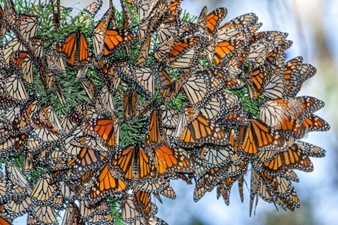Save the Butterflies—but Not to Save Our Food Supply
These insects are lovely, but despite what many think, they aren’t significant contributors to pollinating agriculturally important plants
By: Erica Fleishman
 Credit: Getty Images
Credit: Getty Images
Spring never has been more welcome. After more than a year of isolation, spirits across the country are being reinvigorated by daffodils, birdsong and longer days. In the western United States, however, this change of mood of may be tempered by a recent publication in Science that reported regional declines in the abundance of butterflies—normally another welcome harbinger of seasonal renewal.
If these lovely animals vanished from the United States tomorrow, many of us would feel a profound aesthetic loss. But some scientists, journalists and conservationists go further, claiming that butterflies are essential pollinators, and that the productivity of agricultural crops and native plants would plummet if their populations drop. Whether prompted by naiveté or by calculation, however, the invocation of pollination as a motivation to conserve butterflies misrepresents the best science available. It amounts to false advertising.
More than three quarters of the world’s crops and flowering plants, whether wild or cultivated for human food or ornamentation, are pollinated by animals—primarily by wild and domesticated bees. The much-publicized declines in bee populations because of parasites, diseases, pesticides, habitat loss and climate change indeed may threaten economic systems and food production.
Bees are insects. Butterflies also are insects, but their role in pollination is substantially less than that of bees. An article published in Annual Review of Entomology in 2020 estimated that the global economic value of crops visited by both bees and other insects, such as flies, beetles, moths, and butterflies, was more than 99 percent of that visited exclusively by other insects.
Those who wish to conserve wild species and ecosystems long have sought novel ways to change public attitudes and behaviors related to conservation. In the mid-1980s, for example, the term biodiversity was coined to encapsulate the extraordinary richness of life at all levels. In the 1990s, the concept of ecosystem services was developed to convey the benefits that humans receive from nature at no cost. Pollination is one such service. As the distribution and abundance of bees decreased, some researchers and advocacy organizations, and in turn media outlets, began referring not only to bees but to other groups of insects as pollinators.
References to pollination are especially common when the species in question are day-flying, colorful and likely to evoke a positive emotional response. For example, in discussing the Science publication mentioned above, an article in the Washington Post commented, “The loss of butterflies across Western forests and prairies, like the similar drop in bumblebees nationwide due to rising temperatures, is troubling because both insects play a key role in pollinating crops and wildflowers.”
To illustrate, allusions to monarch butterflies (Danaus plexippus) as pollinators have become increasingly common as the species’ habitat has been lost and the monarchs were proposed for listing under the U.S. Endangered Species Act. For instance, a Web site of the National Park Service notes: “While feeding on nectar, [monarch butterflies] pollinate many types of wildflowers.” This and similar assertions are widespread, but untrue. To the contrary, the scientific evidence suggests that neither milkweed, the food plant for the caterpillar stage of monarch butterflies, nor other wildflowers rely on these butterflies for reproduction. Instead, the physiology of monarch butterflies prevents them from playing a major role in pollination. A 2017 article in Environmental Policy and Governance tracked the history of describing monarch butterflies as pollinators, concluding that the characterization persists because it increases the public prominence of political actors and other voices for conservation.
Some who wish to protect our nation’s lands and waters, including many credible scientists, might argue that it’s acceptable to take some poetic license to encourage those actions. I argue instead that intentional or careless misrepresentation of science to achieve a noble aim is unacceptable and unethical. Over the past four years, like many of my colleagues, I was dismayed by the extent of willful distortion of data, from the existence of anthropogenic climate change to the epidemiology of COVID-19, for the sake of political gain. We winced when lies were called alternative facts, and when the integrity of unimpeachable researchers was questioned. We hung on to the hope that future administrations would be honest and follow the science. Whether one agrees or disagrees with the behavioral change sought via falsified science is irrelevant. No one has the moral high ground.
https://www.scientificamerican.com/article/save-the-butterflies-but-not-to-save-our-food-supply/








